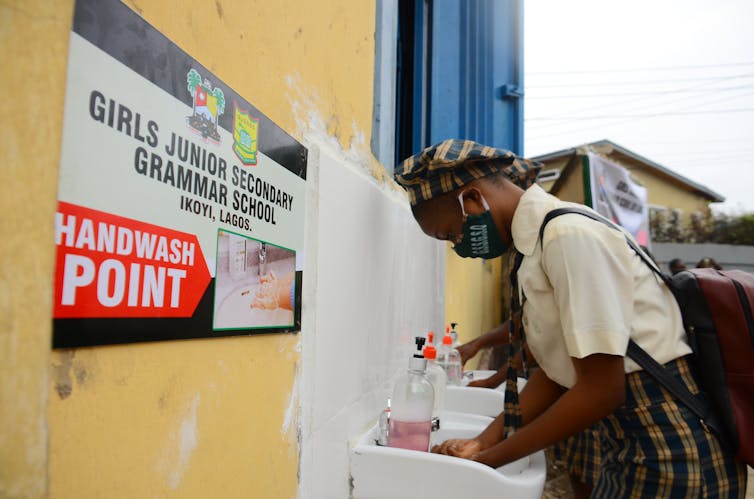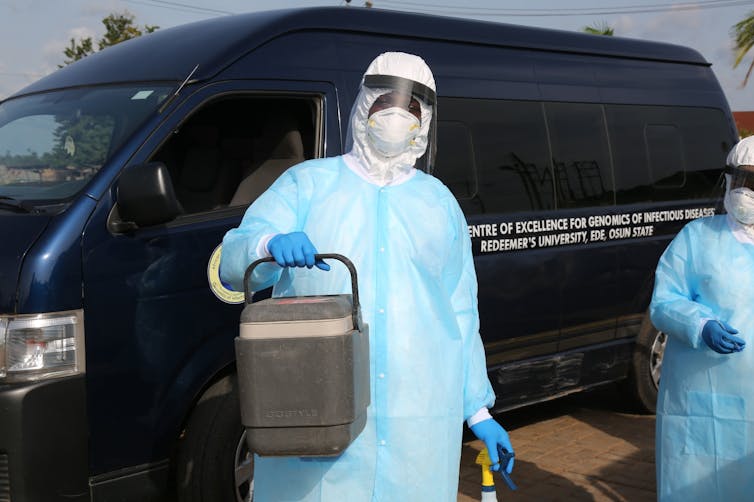
The pace of SARS-CoV-2 transmission has triggered different government responses globally. These have had varying levels of effectiveness and some unintended outcomes.
Nigeria, Africa’s most populous country with many densely populated cities, presents a unique situation for the explosive spread of SARS-CoV-2. Factors include high population density, limited health-care resources and access, and a high poverty index among a range of other socioeconomic factors.
Yet, by early August the number of reported confirmed infections (44,443) and mortality (910) was lower than other countries with dense urban populations and similar socioeconomic challenges.
As we point out in our paper, Insights into the Nigerian CoVID-19 Outbreak, the exact reasons for this are not clear but might include societal, immunological, epidemiological, political and infrastructural factors.
In our paper we set out to describe the ongoing CoVID-19 outbreak and its associated peculiarities. We also identify critical steps that still need to be taken to contain and control the outbreak.
Insights
We found that the CoVID-19 outbreak in Nigeria showed age and sex specific differences. More young people were affected compared to older people. This was different to the global trend.
This age-specific difference was also seen across other African countries. Examples include Ghana and South Africa.
We hypothesise that the age difference in the profile of cases in Nigeria could be due to the lower median age (a more youthful population) in Nigeria and Africa compared to the US and European countries.
Also, there was a sex and gender-based difference in the severity of the outbreak in Nigeria. More males than females have been infected. This is similar to patterns elsewhere in the world.
The reason for this is not clear. Several factors have been suggested. These include the role of sex hormones in the regulation of immune response and the expression of the SARS-CoV-2 receptor.
The expression of the viral receptor - ACE2 - in the Nigerian population should be investigated using various tools such as immunogenetics. This kind of study would help us understand differences in the expression of the receptor across the country, and how this has affected the outcome of the disease.
In immunology, constant exposure to disease causing agents (pathogens) like viruses makes a critical arm of the immune system (innate immune system) more primed to be able to respond quicker and faster to different pathogens. This concept – called trained immunity – is being debated as a possible explanation for the low COVID-19 incidence in Nigeria and Africa due to constant exposure and high burden of different infectious disease.
However, the benefits or detriments of this still have to be fully explored.
Lastly, we argue that public mistrust, misinformation and disinformation could be a major driver of COVID-19 in Nigeria. This mistrust has been an offshoot of the initial widespread dismissal of the reported cases as a “disease of the elite” and an embezzlement ploy for allocated response funds.
This was further reinforced by conspiracy theories emanating from various traditional and online media sources. The consequences of this mistrust were reflected in non-compliance with lockdown rules and social distancing restrictions. This potentially undermined the impact of the government containment response.

Modelling
Our research used the age-stratified SEIR (susceptible-exposed-infected-recovered) model to predict and model the Nigerian COVID-19 outbreak.
This showed that Nigeria is still in the early stages of the outbreak. The expected trajectory depends on the mitigation measures to contain the spread. A surge is expected in the coming months.
It is important to note that the COVID-19 situation in Nigeria is fast evolving. It is therefore difficult to ascertain the efficacy of the mitigation measures.
In addition, this is only a prediction and comes with a level of uncertainty in the parameters and the simplification of the model we used. As with all models, it might not capture the full complexity of the outbreak. But it can help better understand the dynamics of the outbreak. And it can inform government decisions on future interventions.
Consequence and impact
The incidence and spread of COVID-19 has affected Nigerian public health facilities both negatively and positively.
One of the negative consequences includes the impact on other infectious diseases. For example, an evaluation of the Lassa fever epidemiological trend over the past 5 years (2016 – 2020) of the same reporting period (week 1 – 23) also indicates the highest case peak reported in 2020.
This surge might not be absolutely associated with the current COVID-19 outbreak. But the impact of the outbreak would undoubtedly influence resource allocation and the working capacity of the national public health infrastructure.
This suggests that the current pandemic could affect the epidemiology and response to other endemic and integrated diseases. These include cerebrospinal meningitis, malaria, cholera, measles, Lassa fever and Yellow fever.
On a positive note, the COVID-19 outbreak has brought improvements to the health sector. This has included an increase in the implementation of the collaborative One-Health approach. This involves the collaborative participation of stakeholders from the human, animal and environmental health sector.
Examples include the incorporation of veterinarians and environmentalists in the Joint Task Force in response to CoVID-19, and port authorities in the establishment of the Coronavirus preparedness group.
There has also been rapid scale-up and activation of various stand alone laboratories. Lastly, the pandemic has highlighted the enormous potential for genomic surveillance in Nigeria.
But the COVID-19 outbreak, like other infectious disease outbreaks, has exposed the fragile health system in Nigeria. The lack of adequate testing, the poor health infrastructure, sub-optimal investment and funding in the STEM field and inadequate trained health professionals, leave Nigeria on an unknown trajectory.
As we work towards returning to normal, we argue that Nigeria’s leeway out of the COVID-19 outbreak, and other future outbreaks, will require improved diagnostic capacity, effective testing and tracing, and massive investment in research and health infrastructures.![]()
Oyebola Oyesola, Recent PhD graduate from Cornell University, Cornell University; Christian Happi, Professor of Molecular Biology and Genomics, Redeemer's University; Dr Adewole A Adekola, Pathobiology and Population Sciences, Royal Veterinary College, University of London, University of London; Dr Chinedu Ugwu A, Research Fellow/Lecturer, Africa Centre of Excellence for Genomics of Infectious Disease (ACEGID), Redeemer's University, Redeemer's University; Jonathan Heeney, Professor of Comparative Pathology, Cambridge University, University of Cambridge, and Opeoluwa Adewale-Fasoro, Researcher, Molecular Microbiology and Immunology department, Johns Hopkins Bloomberg School of Public Health, Johns Hopkins Bloomberg School of Public Health
This article is republished from The Conversation under a Creative Commons license. Read the original article.









No comments:
Post a Comment